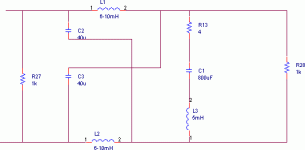Thanks for the interesting reference, Charles.
Any idea about interaction of magnetic fields/eddy currents/static charge?
Bill
Any idea about interaction of magnetic fields/eddy currents/static charge?
Bill
This is a good place to ask.Bill F. said:Any idea about interaction of magnetic fields/eddy currents/static charge? Bill
http://groups.google.com/groups?hl=en&safe=off&group=sci.physics.electromag
I would appreicate some advice about using a piezo element in a MFB unit. I have two magazine articles about DIY MFB with piezos. One was from "Elector" (mid '80s) that ended up in an Aussie mag and the other is a very similar design from a Scandanavian that was published in "The Audio Amateur" some years ago. (It had slightly more elaborate control circuitry.) Both use the piezo element from the Motorola tweeters and fix it inside the dust cap with a bit of araldite. Now neither of the articles I've got are very clear and I can't tell from the photos or the text how to place the piezo. Now I think they want to glue the "coned" part to the dust cap and leave the inertia of the flat piezo disc to generate the flexing and so produce a signal. But on the other hand you could fix the disk around the perimeter and allow the "cone" be free and the subsequent movement of the "cone" to bend the disk.
Has anyone got a clear photo or has succesfully built one of these designs? Which way do you fit it?
Jonathan
Has anyone got a clear photo or has succesfully built one of these designs? Which way do you fit it?
Jonathan
Now I think they want to glue the "coned" part to the dust cap and leave the inertia of the flat piezo disc to generate the flexing and so produce a signal.
That's exactly what they do, because they use it as an accelerometer !
Regards
Charles
Using simple correction nettwork on DVC element and accelerometer. There is some problems onvolved:
1. above resonance the element act as spring mass load, giving 90 * phase shift.
2. at a point there is a coil making another 90* phase shift
feedback will then bee in the wrong way !
At elements resonance the load 😕 ? can i load it ?😕
Below resonanse i want to add sensitivity, at infinite i want no sensitivity.
And i want too get rid of that 180 * delayed output abowe critical freq. (at a point). I figure this nettwork will come werry close for a DVC element optimalised for feedback.
R27 and R28 beeng the terminals on the element. (Feed at R27)
1. above resonance the element act as spring mass load, giving 90 * phase shift.
2. at a point there is a coil making another 90* phase shift

feedback will then bee in the wrong way !
At elements resonance the load 😕 ? can i load it ?😕
Below resonanse i want to add sensitivity, at infinite i want no sensitivity.
And i want too get rid of that 180 * delayed output abowe critical freq. (at a point). I figure this nettwork will come werry close for a DVC element optimalised for feedback.
R27 and R28 beeng the terminals on the element. (Feed at R27)
Attachments
I believe the Philips MFB woofers in the mid seventies used a piezo element with an attached metal weight. I guess the resonance frequency of the piezo element would be way above the regular subwoofer frequency band.
Here's a page from a 1973 Philips catalog , scroll to the bottom to a picture of the woofer:
http://www.mfbfreaks.com/folders/ph1973hifi/imagepages/image17.html
http://www.mfbfreaks.com/folders/ph1973hifi/imagepages/image17.html
Hi,
this is in french, written by Jean-Claude Bodot, but at least some schematics in the pdf files can help anybody interested in servo-speakers :
http://www.delapucealoreille.com/article-18098822.html
Various texts I collected :
http://cyrille.pinton.free.fr/electroac/lectures_utiles/asservissement/
Back to the beginning of this discussion which started six years ago, it must be said that there is a great intimity between the concepts of using negative resistance amplifiers and of bridge servo-control configurations.
This was known by the pionners and is made very clear in Bodot's writing.
this is in french, written by Jean-Claude Bodot, but at least some schematics in the pdf files can help anybody interested in servo-speakers :
http://www.delapucealoreille.com/article-18098822.html
Various texts I collected :
http://cyrille.pinton.free.fr/electroac/lectures_utiles/asservissement/
Back to the beginning of this discussion which started six years ago, it must be said that there is a great intimity between the concepts of using negative resistance amplifiers and of bridge servo-control configurations.
This was known by the pionners and is made very clear in Bodot's writing.
I think this somehow corresponds to the thread:
http://www.diyaudio.com/forums/showthread.php?s=&threadid=125510
If it doeasn't, sorry for OT.
Regards
Adam
http://www.diyaudio.com/forums/showthread.php?s=&threadid=125510
If it doeasn't, sorry for OT.
Regards
Adam
Back shot of my Nivox Model 4 Studio Monitors with MFB Alnico 12" Bass:
Sounds really nice, clean and goes very loud. I still can't get the second one to work though.
-Micha
An externally hosted image should be here but it was not working when we last tested it.
Sounds really nice, clean and goes very loud. I still can't get the second one to work though.

An externally hosted image should be here but it was not working when we last tested it.
-Micha
- Status
- Not open for further replies.

